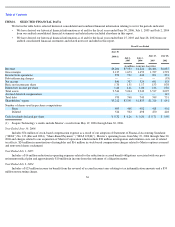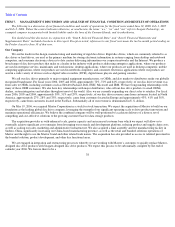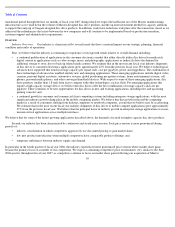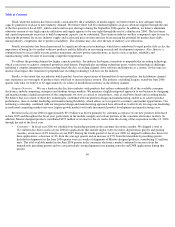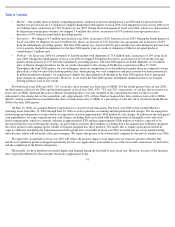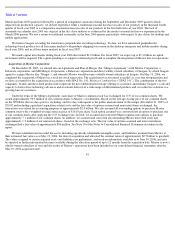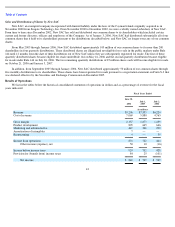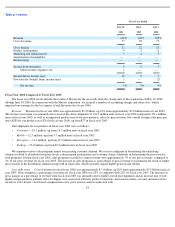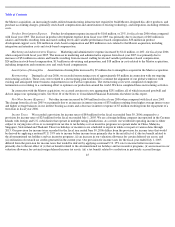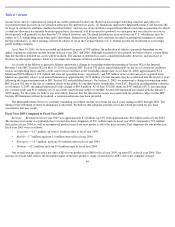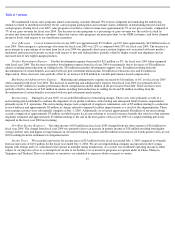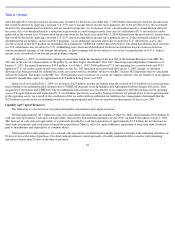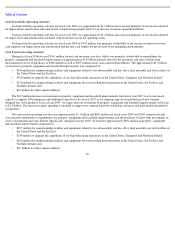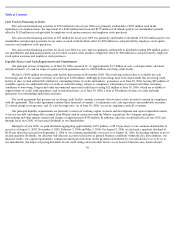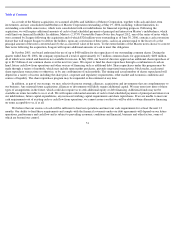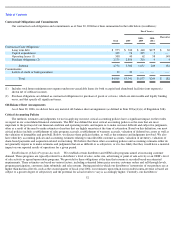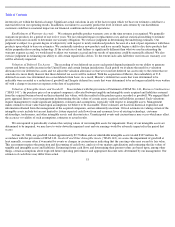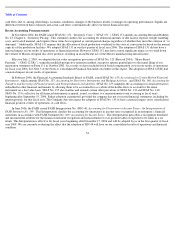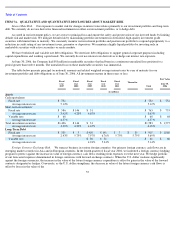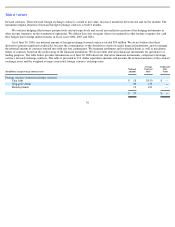Seagate 2005 Annual Report Download - page 48
Download and view the complete annual report
Please find page 48 of the 2005 Seagate annual report below. You can navigate through the pages in the report by either clicking on the pages listed below, or by using the keyword search tool below to find specific information within the annual report.
Table of Contents
income taxes, and (iv) utilization of research tax credits generated in that year. Based on our foreign ownership structure and subject to
(i) potential future increases in our valuation allowance for deferred tax assets, (ii) limitations imposed by Internal Revenue Code Section 382
on usage of certain tax attributes (further described below), and (iii) use of tax attributes acquired from Maxtor and other acquisitions for which
a valuation allowance has initially been recognized that, if reversed, will be reversed to goodwill, we anticipate that our effective tax rate in
future periods will generally be less than the U.S. federal statutory rate. Dividend distributions received from our U.S. subsidiaries may be
subject to U.S. withholding taxes when and if distributed. Deferred tax liabilities have not been recorded on unremitted earnings of certain
foreign subsidiaries, as these earnings will not be subject to tax in the Cayman Islands or U.S. federal income tax if remitted to our foreign
parent holding company.
As of June 30, 2006, we have recorded net deferred tax assets of $78 million, the realization of which is primarily dependent on our
ability to generate sufficient taxable income in fiscal years 2007 and 2008. Although realization is not assured, we believe that it is more likely
than not that these deferred tax assets will be realized. The amount of deferred tax assets considered realizable, however, may increase or
decrease in subsequent quarters, when we reevaluate our estimates of future taxable income.
As a result of the Maxtor acquisition, Maxtor underwent a change in ownership within the meaning of Section 382 of the Internal
Revenue Code (IRC Section 382) on May 19, 2006. In general, IRC Section 382 places annual limitations on the use of certain tax attributes
such as net operating losses and tax credit carryovers in existence at the ownership change date. As of June 30, 2006, approximately $1.4
billion and $378 million of U.S. federal and state net operating losses, respectively, and $39 million of tax credit carryovers acquired from
Maxtor are generally subject to an annual limitation of approximately $110 million. Certain amounts may be accelerated into the first five years
following the acquisition pursuant to IRC Section 382 and published notices. On January 3, 2005, we underwent a change in ownership under
IRC Section 382 due to the sale of common shares to the public by our then largest shareholder, New SAC. Based on an independent valuation
as of January 3, 2005, the annual limitation for this change is $44.8 million. As of June 30 2006, there are $447 million of U.S. net operating
loss carryforwards and $111 million of U.S. tax credit carryforwards subject to the IRC Section 382 limitation associated with the January 3,
2005 change. To the extent we believe it is more likely than not that the deferred tax assets associated with tax attributes subject to this IRC
Section 382 limitation will not be realized, a valuation allowance has been provided.
The Internal Revenue Service is currently examining our federal income tax returns for fiscal years ending in 2001 through 2004. The
timing of the settlement of these examinations is uncertain. We believe that adequate amounts of tax have been provided for any final
assessments that may result.
Fiscal Year 2005 Compared to Fiscal Year 2004
Revenue. Revenue for fiscal year 2005 was approximately $7.6 billion, up 21% from approximately $6.2 billion in fiscal year 2004.
The increase in revenue was primarily due to record disc drive shipments of 98.1 million units in fiscal year 2005 compared to 79.3 million
units in fiscal year 2004, as well as an improved product mix of our new products, offset by price erosion. Unit shipments for our products in
fiscal year 2005 were as follows:
•
Consumer —16.7 million, up from 6.3 million units in fiscal year 2004.
•
Mobile
— 5.7 million, up from 3.6 million units in fiscal year 2004.
•
Enterprise
—13.5 million, up from 10.4 million units in fiscal year 2004.
Our overall average sales price per unit (ASP) for our products was $80 for fiscal year 2005, up from $71 in fiscal year 2004. This
increase in overall ASP reflects the favorable impact of the new products, many of which have ASP’s above the company average.
46
•
Desktop
—62.2 million, up from 59.0 million units in fiscal year 2004.


